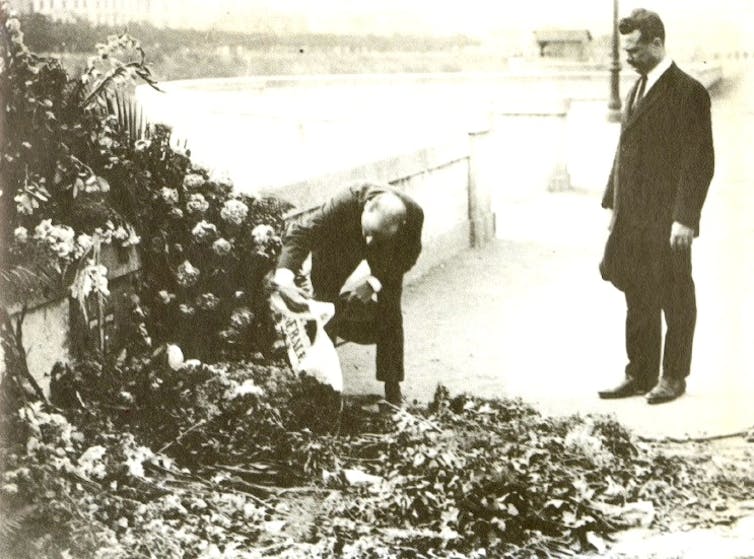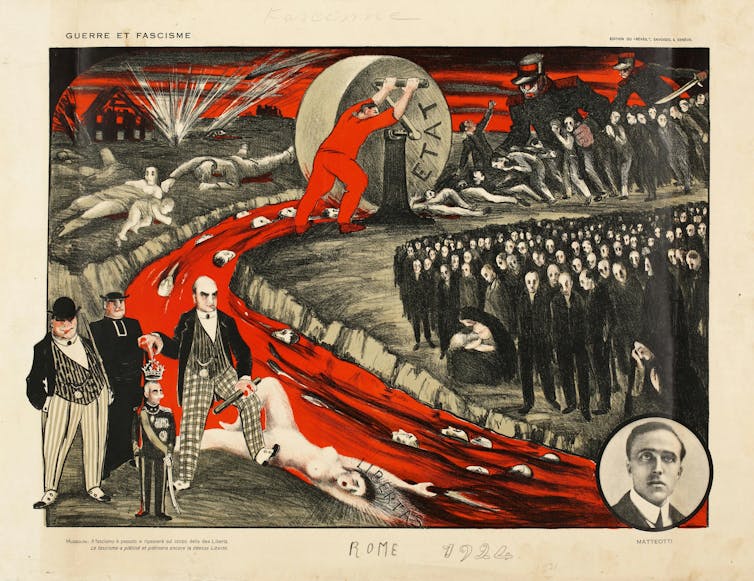Since coming to power, Italian prime minister Giorgia Meloni and her party Brothers of Italy have repeatedly raised the question of who and what is remembered in Italy. They have paid particular attention to how the experience of Italian fascism is told.
Writing on the front page of newspaper Corriere della Sera, Meloni questioned the way the nation marks April 25 – the day Italy remembers its liberation from Nazi-fascism and honours the victory of the Italian resistance. She implied that those with rightwing political views are effectively locked out of the commemoration. She suggested that “the category of fascism” is used as a “weapon of mass exclusion” so that certain groups or people are not included on the “list” of those allowed to celebrate the anniversary.
The implication was that people associated with fascism should also be recognised for their contribution to the democratic republic. Referring to the Italian Social Movement, founded in 1946 by people who wanted to revive fascism and fight communism, Meloni wrote: “those who were excluded from the constitutional process for obvious historical reasons undertook to lead millions of Italians into the new parliamentary republic, shaping the democratic right wing”. Several Brothers of Italy leaders cut their teeth in the party’s youth group, including Meloni.
Meloni’s letter, published on a day intended to mark freedom from fascism, was remarkable for its failure to mention “antifascism” once.
Since its foundation a decade ago, Brothers of Italy has made the memory of the Italian far right and commemoration of its victims a priority. The party advocates for a broad national memory culture that even honours former fascists, dissolving the fascist-antifascist binary upon which the democratic republic was built.
It is behind longstanding calls to dedicate a road in Italy’s capital to Giorgio Almirante, founder and leader of the Italian Social Movement. Almirante was a minister in the Italian Social Republic – the second incarnation of the fascist state between 1943 and 1945 – and an editor of The Defence of the Race magazine, which promoted biological racism.
Most recently, Brothers of Italy co-founder Ignazio La Russa, president of the Italian Senate, asserted that the partisans involved in the 1944 Via Rasella attack – an attack by the Italian resistance in Nazi-occupied Rome – had killed a “semi-retired band” of musicians. The real victims were Nazis. Casting partisans as villains, these historical inaccuracies poke at the moral foundations of the antifascist republic, distorting and confusing the past.
The original contested memory
Fascists recognised the significance of gaining control of commemoration as early as 1924. This is when Benito Mussolini introduced a series of restrictions designed to banish the memory of antifascist victims. His move came in response to antifascists leaving red carnations in memory of socialist leader Giacomo Matteotti at the site in Rome where he was kidnapped in 1924. Matteotti was a staunch and vocal opponent of Mussolini and was murdered by Mussolini’s henchmen. His body was found on August 16 1924 just outside the city.
In the six weeks between his disappearance and the recovery of his body, tributes were laid, removed and replaced at the kidnap site, creating a grassroots site of memory. A cross was drawn on an embankment wall and red wreaths and carnations laid – material symbols of an emerging antifascist memory culture.

Mussolini responded with a ban on flowers, commemorative ribbons and gatherings within ten metres of the site. He even tried to force Matteotti’s family to adopt a new name. In January 1925, he accepted “political, moral and historical responsibility” for Matteotti’s murder in a pivotal speech. He then introduced a series of laws that banned opposition parties, curtailed press freedoms, introduced a secret police force and made the head of government accountable only to the King. It was the cementing of a dictatorship.
Mussolini’s ban pushed memory into private space in Italy. But commemoration of Matteotti abroad was public, persistent and popular. It occurred as far away as Australia, the United States and Venezuela and closer to home in Paris, London and Vienna.
Monuments to Matteotti went up as far away as Buenos Aires, where a statue of him is dedicated to all workers and emigrants. His name was visible in urban space: the social housing complex in Vienna named Matteotti Hof still stands today, and there are several streets named after him in France.

When Mussolini resigned in July 1943, Matteotti’s name returned to Italian public space. As Allied forces and Italian partisans fought to free the country from fascism city by city, streets dedicated to fascist heroes were renamed. Matteotti’s name became more visible – a marker of the progress of Italy’s liberation. Today, more than 3,200 sites bear Matteotti’s name in Italy.
Far from being the decision of a few gatekeepers, this overwriting of fascist heroes was official policy in the new, democratic republic. With Brothers of Italy in power, the names of far-right figures could return to public space. Earlier this year, the centre-right city council in Grosseto laid out its plans for a new district of the city. Its main road – National Pacification Street – will fork with a road dedicated to Enrico Berlinguer on the left, honouring the longstanding leader of the Italian Communist Party, and another honouring Giorgio Almirante on the right.
There is more at stake than just political wins. This is a dangerous attempt to undermine the values on which the republic was founded by reframing the way Italy remembers its past.
Amy King does not work for, consult, own shares in or receive funding from any company or organisation that would benefit from this article, and has disclosed no relevant affiliations beyond their academic appointment.
This article was originally published on The Conversation. Read the original article.






